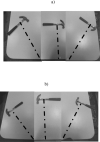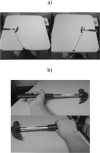The effects of handedness and reachability on perceived distance
- PMID: 19968426
- PMCID: PMC3291021
- DOI: 10.1037/a0016875
The effects of handedness and reachability on perceived distance
Abstract
Previous research has suggested that perceived distances are scaled by the action capabilities of the body. The present studies showed that when "reachability" is constrained due to a difficult grasp required to pick up an object, perceived distance to the object increases. Participants estimated the distances to tools with handle orientations that made them either easy or difficult to grasp with their dominant and nondominant hands. Right-handed participants perceived tools that were more difficult to grasp to be farther away than tools that were easier to grasp. However, perceived distance did not differ in left-handed participants. These studies suggest that, when reaching toward a target, the distance to that target is scaled in terms of how far one can effectively reach, given the type of reaching posture that is executed. Furthermore, this effect is modulated by handedness.
Figures








References
-
- Annett M. The binomial distribution of right, mixed and left handedness. The Quarterly Journal of Experimental Psychology. 1967;19(4):327–333. - PubMed
-
- Bhalla M, Proffitt DR. Visual-Motor Recalibration in Geographical Slant Perception. Journal of Experimental Psychology: Human Perception and Performance. 1999;25(4):1–21. - PubMed
-
- Bertamini M, Yang TL, Proffitt DR. Relative size perception at a distance is best at eye level. Perception & Psychophysics. 1998;60(4):673–682. - PubMed
-
- Binkofski F, Buccino G, Posse S, Seitz RJ, Rizzolatti G, Freund HJ. A fronto-parietal circuit for object manipulation in man: evidence from an fMRI-study. European Journal of Neuroscience. 1999;11:3276–3286. - PubMed
-
- Carello C, Grosofsky A, Reichel FD, Solomon HY, Turvey MT. Visually perceiving what is reachable. Ecological Psychology. 1989;1:27–54.

